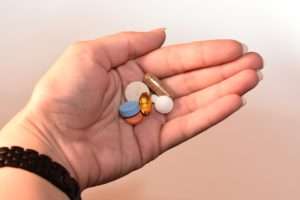One of the joys of being a pharmacist is that you get to hear patients describe their medical conditions to you. Jay Harold wrote this post, “6 Groups & Meds Affected by Fungal (Nail) Infections,” because we need to know more about fungal infections.
Fungi are everywhere. Sometimes, they are too small to see with the naked eye. Fungi live:
- Outdoors, for example, in soil, and on plan
- Indoors, on surfaces and in the air
- On people’s skin and inside the body
There are millions of fungal species, but only a few hundred of them can make people sick. Molds, yeasts, and mushrooms are all types of fungi1 .
Fungi can cause many different types of illnesses, including:
- Asthma or allergies. Learn more about mold and how it can affect your health.
- Rashes or infections on the skin and nails
- Lung infections (pneumonia), with symptoms similar to the flu or tuberculosis
- Bloodstream infections
- Meningitis
Who Gets Fungal Infections2 ?
Fungal infections can also happen in people without weak immune systems. Fungal infections that are not life-threatening, such as skin, nail, or vaginal yeast infections, are common. Some infections can be more serious. Lung infections like Valley fever or histoplasmosis can happen in people who live in or visit certain areas.
Anyone can get a fungal infection, even people who are otherwise healthy. Fungi are common in the environment, and people breathe in or come in contact with fungal spores every day without getting sick. However, in people with weak immune systems, these fungi are more likely to cause an infection.
People with weak immune systems
Infections that happen because a person’s immune system is weak are called opportunistic infections. These illnesses can be caused by bacteria, viruses, or fungi. Many fungal infections are opportunistic infections.

What weakens an immune system?
Some people are born with a weak immune system. Others may have an illness that attacks the immune system, such as HIV/AIDS. Some medications, like corticosteroids or cancer chemotherapy, can also lower the body’s ability to fight infections.
If you have a weakened immune system, you should be aware that fungal infections can happen. Learning about fungal infections can help you, and your doctor recognizes them early. This may help prevent serious complications.
Click on the topics below to learn more about how fungal infections affect specific groups of people.
- People living with HIV/AIDS
- Organ transplant patients
- Cancer patients
- Hospitalized patients
- Stem cell transplant patients
- People taking medications that weaken the immune system
Overall, most fungal severe infections are rare, but they do happen. They are most common among people with weak immune systems. People with certain health conditions may need to take medications with side effects that can weaken your immune system and put you at risk for fungal infections.
Specifically, corticosteroids and TNF (tumor necrosis factor) inhibitors are two types of medications that can increase your chances of getting a fungal infection.
- Corticosteroids are medications that treat conditions, including arthritis, asthma, allergic reactions, and autoimmune diseases such as lupus, sarcoidosis, or inflammatory bowel disease.
- TNF inhibitors are medications that treat autoimmune diseases such as rheumatoid arthritis, psoriasis, and inflammatory bowel disease.
Medications that can increase the chances of getting a fungal infection3

Corticosteroids taken by mouth can increase your chance of getting a serious fungal infection. Oral corticosteroids include the following:
- Budesonide (Entocort EC)
- Cortisone (Cortone)
- Dexamethasone (Decadron)
- Hydrocortisone (Cortef)
- Methylprednisolone (Medrol)
- Prednisolone (Prelone)
- Prednisone (Deltasone)
- Triamcinolone
Some fungal infections can be serious, such as:
- Coccidioidomycosis (Valley fever)
- Cryptococcosis (neoformans and gattii)
- Histoplasmosis
- Pneumocystis pneumonia (PCP)
- Invasive Candida infection

- Invasive aspergillosis
Other fungal infections, such as oral candidiasis (thrush), are usually not life threatening.
What you need to know about fungal infections
Fungal infections can range from mild to life-threatening. Some fungal infections are mild skin rashes, but others can have serious complications. Because of this, it’s essential for you to seek treatment as soon as possible to avoid serious infection.
Fungal infections can look like bacterial or viral infections. If you’re taking medicine to fight an infection and you aren’t getting better, ask your doctor about testing you for a fungal infection.
Where you live (geography) matters. Some disease-causing fungi are more common in certain parts of the world. If you live in or visit these areas and are taking medications that weaken the immune system, you’re more likely to get these infections than the general population. For more information on travel-related illnesses, please see the CDC Traveler’s Health site.
The length of your treatment matters. Your healthcare provider can prescribe corticosteroids for short-term use (days to weeks) or long-term use (weeks to months). Long-term corticosteroid use is more likely to increase your chance of getting a fungal infection.
Amount of medication (dose). Higher doses of medicines that weaken your immune system are more likely to increase your risk of getting a fungal infection.
Click on the sections below to see lists of corticosteroids and TNF inhibitors that can increase the chances of getting a fungal infection.
Fungal Nail Infections4
Definition
Symptoms
Nails with a fungal infection are often:

- Discolored (yellow, brown, or white)
- Thick
- Fragile or cracked
A fungal nail infection usually isn’t painful unless it becomes severe.
Some people who have fungal toenail infections also have a fungal skin infection on the foot, especially between the toes (commonly called “athlete’s foot”).
How does someone get a fungal nail infection?
Fungal nail infections can be caused by many different types of fungi (yeasts or molds) that live in the environment. Small cracks in your nail or the surrounding skin can allow these germs to enter your nail and cause an infection.
Who gets fungal nail infections? (5 Conditions)
Anyone can get a fungal nail infection. Some people may be more likely than others to get a fungal nail infection, including older adults and people who have the following conditions:
- A nail injury or nail surgery
- Diabetes
- A weakened immune system
- Blood circulation problems
- Athlete’s foot (ringworm on the foot)
Prevention
- Keep your hands and feet clean and dry.
- Clip your fingernails and toenails short and keep them clean.
- Don’t walk barefoot in areas like locker rooms or public showers.

- Don’t share nail clippers with other people.
- When visiting a nail salon, choose a salon that is clean and licensed by your state’s cosmetology board. Make sure the salon sterilizes its instruments (nail clippers, scissors, etc.) after each use, or, you can bring your own. Please click here for more information about nail hygiene.
Diagnosis
Your healthcare provider may diagnose a fungal nail infection by looking at the affected nail and asking questions about your symptoms. He or she may also take a nail clipping to look at under a microscope or send to a laboratory for a fungal culture.
Treatment
Fungal nail infections can be challenging to cure, and they typically don’t go away without antifungal treatment. The best treatment for a fungal nail infection is usually prescription antifungal pills taken by mouth. In severe cases, a doctor might remove the nail completely. It can take several months to a year for the infection to go away.
Information for Healthcare Professionals
Topical antifungal agents can be used but are often ineffective. Oral terbinafine is considered to be the first-line treatment for confirmed onychomycosis; the treatment course is generally six weeks for fingernails and 12 weeks for toenails. Azoles can also be used. Surgical debridement or removal of the affected nail is also a consideration for cases that are resistant to antifungals, and laser treatments for onychomycosis appear to be a promising area for future study.
Jay Harold hopes you enjoyed this post, “6 Groups & Meds Affected by Fungal (Nail) Infections”. Please Share it and read more about Jay Harold here. Please take this advice from Muhammad Ali and give back to others. “Service to others is the rent you pay for your room here on earth.”




